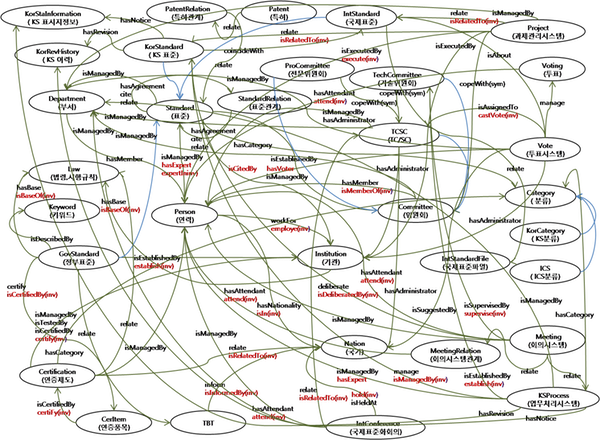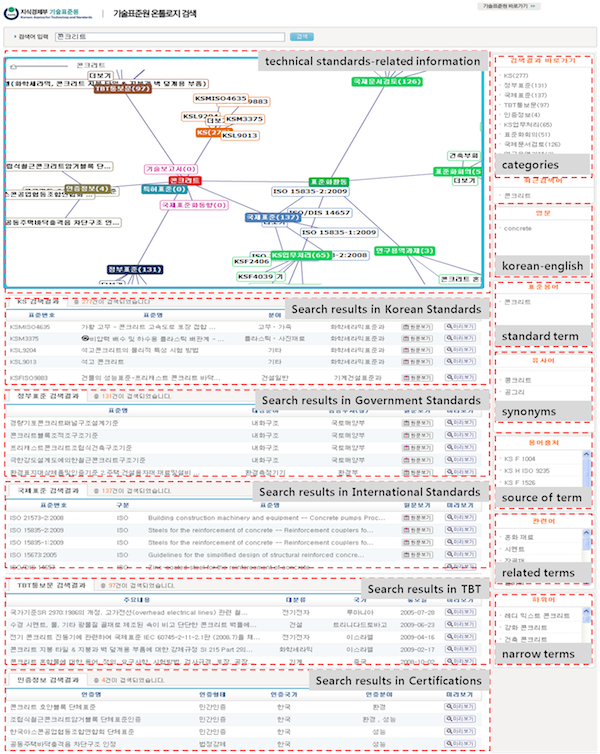July 2010

There is growing need for an integrated and connected search service for technical standards that will provide convenient access to information on government standards, certification activities, and trends at home and abroad for the public and business. There are also needs for a means to promote diffusion of standards and their widespread use by obtaining all relevant information involved with a specific standard at once, including standard terminologies, domestic and foreign specifications related to standard specifications, experts in the field, information on technical barriers, etc. As an example, The European Union, through the Technical Regulations Information System (TRIS), provides technical regulations of EU member countries in a transparent manner. Canada also provides information on relevant laws and regulations as well as technical standards through their Gazette system. In Korea, the Korean Agency for Technology and Standards (KATS), a government service agency that establishes and manages domestic technical standards, can now provide rich technical standards-related information based on Semantic Web technologies.
KISTI developed an integrated and connected search service for technical standards information on behalf of KATS, through which users can obtain all information on a specific technical standard at once, by modeling technical standards-related information with an ontology and interconnecting the information through inference. This service is expected to maximize the scope of provision and the use of technical standards-related information such as technical standards, trends in standards, standards-related activities and research on standardization, and to enable the public and businesses to understand and use technical standards more easily, thereby contributing to enhancement of the national competitiveness in technology.
We have to find some measures to maximize the scope of provision and the use of heterogeneous information on technical standards in the service. It’s not easy for a user to access from non-standard terminology to technical standards-related terminology and information. It is important to improve information accessibility in establishing and amending technical standards and a more systematic management for technical standards-related information is required in the service.
We modeled an ontology for the following technical standards-related information and clarified correlations between different information:
To convert heterogeneous data in DBMS to RDF triples, we assigned URI to each object and clearly defined the properties between objects. We also developed functions to gather updated data, compare pre-assigned URIs and generate RDF triples.
To support access from non-standard terminology to information on technical standards, a technical standards-related terminology thesaurus was established based on search terms of the Korean Standards Information Center and terminologies of KS technical standards. The service showed search terms with standard terms (Korean-English pair), related terms, synonyms, and hypernyms/hyponyms.
To ensure convenient access to information, all information related to the search term is shown in a single search result page by the consolidation service.

Figure 1 illustrates the ontology model designed for the integrated, connected search service for technical standards information. The ontology expresses the correlations between relevant information on technical standards and expands them through inference. (A larger version of the figure is also available)
As the future work, we plan to extend standards terminology thesaurus and the scope of standards-related information. This will improve the system performance and provide better services to the public and businesses. We also plan to spread and apply the ontology-based model for integrated and connected service for technical standards information to other standards-related organizations at home and abroad and link their systems with one another.

Figure 2 shows a search example. The query, “concrete,” is entered in the box on the top left side of the page, and its results—various technical standards-related information for this particular query including international and domestic standards, government standards, patent standards, technical standardization activities and certification—are shown in a graph. Also, all search results are shown in a single page, which also displays related terms on the right side. (A larger version of the figure is also available)
© Copyright 2005-2010, Korea Institute of Science and Technology Information (KISTI)